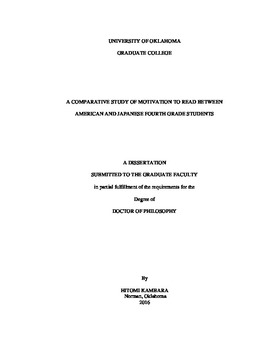| dc.description.abstract | This dissertation investigated and compared motivation to read between American and Japanese fourth grade students. In addition, this study examined critical factors impacting reading motivation of the fourth graders in the two countries. The mixed method explanatory sequential design was employed. A total of 94 American and 102 Japanese fourth grade students completed a Motivation for Reading Questionnaire (MRQ) by Wigfield and Guthrie (1997). Based on their MRQ scores, all students in each country were categorized into three groups: high, medium, and low. Four students from each motivation group were selected for semi-structured interviews to help the researcher explore critical factors impacting reading motivation of the study’s participants in each country. Both descriptive statistics and independent sample t-test were employed to analyze quantitative results. In addition, constant comparative method and thematic analysis were used to qualitatively identify categories and themes related to critical factors influencing students’ motivation to read in each country. The results revealed that American and Japanese students show statistically significant differences in all three categories of motivation to read—competence and efficacy beliefs, goals for reading, and social purposes for reading—as well as the MRQ composite score. The researcher also analyzed and compared the top 10 highest scored items across the two groups. Within the category of competence and efficacy beliefs, American students showed a strong sense of self-efficacy, while Japanese students had a moderate to low sense of self-efficacy. While American students showed signs of work avoidance when it came to materials with difficult words or vocabulary questions, Japanese students demonstrated a tendency to read challenging but interesting materials. Regarding goals for reading, involvement, curiosity, and importance were factors impacting intrinsic motivation to read for both American and Japanese students. Regarding extrinsic reading motivation, grades were the only critical factor concerning Japanese students, but competition, recognition, and grades were all critical factors for American students. In regard to social purposes for reading, compliance was the most important factor for Japanese students, while American students scored low on this factor. Analysis of the interview data supported some of the major findings from the analysis of the MRQ and further identified critical factors affecting American and Japanese students’ reading motivation. This study suggests that cultural values play a significant role in students’ motivation to read. It also supports the view of sociocultural theories that an individual’s learning and development are closely tied to social and cultural contexts in which the learner is situated. Important implications for instruction in both countries as well as implications for future research are also discussed. | en_US |
